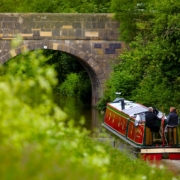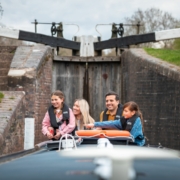Exploring the beautiful Mon & Brec
By The Countryman editor Mark Whitley

Britain’s canals were a product of the Industrial Revolution, built to serve the country’s economic needs, but in recent decades the canal network’s primary purpose has changed from industry to leisure, and nowadays canals are places for recreation and exploration — especially by boat.
The Monmouthshire and Brecon Canal (known affectionately as the ‘Mon & Brec’) is one of our most beautiful and peaceful waterways. It meanders through the South Wales countryside for 35 miles between Brecon and Cwmbran. Built as a ‘contour’ canal, it winds along above the wooded Usk Valley, with panoramic views across the valley to the Black Mountains and Brecon Beacons.
The Mon & Brec is currently inaccessible from any other waterway and, being a rural canal, it does not pass through any large towns or cities, and so remains totally unspoilt. A boat trip along the Mon & Brec is perfect for narrowboat novices, particularly over a week. It’s lovely and quiet, thee plenty of places to stop en route and there are only six locks along the entire length of the waterway.
The Mon & Brec was originally two separate canals — the Monmouthshire Canal, and the Brecknock & Abergavenny Canal, both built in the 1790’s to transport iron, coal and lime. The two canals were finally linked at Pontymoile in 1812, with the amalgamation of both canals in 1865 as the Monmouthshire & Brecon Canal. The stretch of the Mon & Brec still navigable nowadays is mostly the former Brecknock & Abergavenny. And a very picturesque stretch it is, too — though there are still reminders of the canal’s industrial heyday.
Day 1: Goytre Wharf–Gilwern – 8.5 miles, 3 hours’ boating (all times approx)
My exploration of the Mon & Brec began on a summer Friday afternoon at Drifters’ narrowboat hire base Goytre Wharf. Goytre Wharf itself is well worth exploring, either before or after your narrowboat trip. There is an exceptionally well-preserved set of limekilns. The legacy of the Mon & Brec’s role in the lime industry is impressive, with seven sets of kilns still in existence. Other reminders of the canal’s industrial heritage include an aqueduct and Machine Cottage. There is also a heritage centre, shop and café.
At the boat yard, the helpful and friendly staff welcome me and my two companions, and give us a helpful overview of the well-appointed narrowboat which will be our home-from-home for the next week.
Before long we’re setting off and enjoying a pleasant cruise past Llanfoist and Govilon to our planned overnight stop at Gilwern, where we moor up and head off to the nearby Beaufort Arms for a well-earned drink or two, before returning to our boat for a home-cooked meal and a relaxing night’s sleep.
Day 2: Gilwern—Llangattock; 3.5 miles, 1.5 hours
There isn’t much boating planned for today, so we enjoy a leisurely breakfast before continuing on Llangattock, our next overnight stop. We decide to moor up at Bridge 106 for lunch, then head off on foot over the bridge and up an easy-to-follow footpath to the hamlet of Llanelli and its medieval church. From here, there are panoramic views back down over the canal and the Usk Valley to the Black Mountains.
Once back on board, we continue to Llangattock. An easy half-mile walk downhill through Llangattock (look out for the footpath past the church which goes through fields) leads to the attractive town of Crickhowell, where a 17th-century bridge spans the River Usk. Alongside is the Crickhowell Bridge Inn, a perfect spot to while away a warm summer’s evening.
Day 3: Llangattock–Talybont; 8.5 miles, 5 locks, 5 hours
From Llangattock, we continue on to Llangyndir Locks, a flight of five locks which lift the canal 50 feet. These are the only locks we’ll encounter en route. Navigating a lock is easy – just take your time, be guided by any volunteer lock-keepers on duty and “Imagine a bath with a plug and taps at both ends, which you have to empty and fill” (which is the best description I was ever given).
We continue to our overnight stop at Talybont. It’s a beautiful spot, with the classic combination of canal, spectacular views and canalside pubs, and we decide to change our plans and stop off here on our return journey — a decision we reach over drinks in the White Hart Inn … or maybe it was in the beer garden of the Star Inn?
Day 4: Talybont—Brecon; 6.5 miles, 2 hours
Our exploration of the Mon & Brec reaches its halfway point at journey’s end: Brecon, where the canal terminates. We moor up at the canal basin in plenty of time to fully explore this attractive market town. As a first-time visitor, I’m impressed with Brecon. It’s a thriving place, with lots of history and a good selection of shops to stock up on supplies. For our evening meal we decide to eat out at the Clarence pub, close to the canal basin.
Day 5: Brecon—Talybont; 6.5 miles, 2 hours
It’s deja vu today, albeit in reverse, as we begin our return journey with a pleasant couple of hours’ boating back to Talybont. Since we’ve already done this stretch, it’s a chance to relax even more and enjoy the rich diversity of wildlife and wildlife habitats — all indicative of a healthy ecosystem.
Day 6: Talybont—Llangattock; 8.5 miles, 5 locks, 5 hours
Going down! Today we navigate Llangyndir Locks again, descending this time. Our overnight stop is Llangattock, as on our outward journey.
Day 7: Llangattock—Goytre Wharf; 12 miles, 5 hours
This is the longest day in terms of miles navigated, since we plan to boat all the way back to Goytre Wharf today, so that we are right next to the marina for departure day tomorrow morning. The other option would be to stop overnight a little way from the marina and boat in the next morning, but we prefer to do it this way, based on our previous boating experiences.
Day 8: Disembarking
We disembark in the morning, well before the 10am cut-off point, and load up the car, sad to depart after such an enjoyable adventure. Beautiful countryside, diverse wildlife habitats, impressive architectural remains, and an excellent selection of places to eat and drink — an exploration of the Mon & Brec has much to recommend it.









